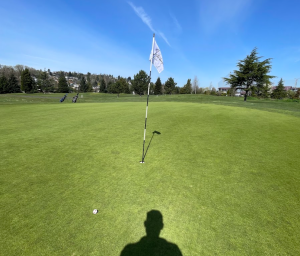Okay, you’ve managed to hit a few decent shots, you haven’t (completely) lost all your balls, and you’ve even remembered to replace a divot or two. But then comes the moment of truth: the scorecard. Suddenly, numbers are flying around, people are talking about “net” and “gross,” and you’re just scribbling down whatever feels right (which, let’s be honest, is probably way higher than you hoped!).
Fear not, my fellow number-challenged golfers! Understanding basic golf scoring isn’t as complicated as it seems, and this whole “handicap” thing? Well, it’s basically golf’s way of trying to make things fair and fun, even when one person hits the ball like a rocket and the other (ahem, me) is still figuring out which end of the club to hold.
Let’s break down the basics of keeping score, what to do when your ball goes rogue, and demystify the concept of handicaps, all in newbie-friendly terms.
The Stroke Heard ‘Round the Course: Counting Your Swings
The fundamental principle of golf scoring is simple: you count the number of strokes it takes you to get the ball in the hole on each hole. That’s it. Every swing you take, including putts, counts as one stroke.
- Honesty is the Best Policy (Even When It Hurts): Be honest with yourself (and your playing partners) about how many shots you’ve taken. No one’s expecting perfection, especially when you’re starting out.
- From Tee to Green (and In the Hole!): You start counting from your first shot on the tee box and keep going until your ball disappears into that little 4.25-inch hole on the green.
- The Scorecard: The scorecard will list each hole, its par (the expected number of strokes for a skilled golfer), and a space for you to write down your score for that hole.
Par for the Course: Understanding the Target Score
You’ll see the word “Par” all over the scorecard. It represents the standard number of strokes it should take a good golfer to complete a hole.
- Par 3s: Generally shorter holes that you should be able to reach the green in one shot and then take two putts.
- Par 4s: Medium-length holes that usually require a tee shot to the fairway, an approach shot to the green, and then two putts.
- Par 5s: Longer holes that typically take two good shots to get near the green and then a chip or pitch and two putts.
- Total Par: The scorecard will also show the total par for the entire 18-hole course (usually around 70–72).
How You Did: Relating Your Score to Par
Once you’ve tallied up your strokes for a hole, you can see how you did compared to par:
- Birdie: One stroke under par (e.g., scoring a 3 on a par 4). That’s a good one!
- Par: Exactly the expected number of strokes. Solid!
- Bogey: One stroke over par (e.g., scoring a 5 on a par 4). Happens to the best of us (especially me!).
- Double Bogey: Two strokes over par. Starting to feel a bit rough.
- And so on… The further over par you go, the higher your score for that hole.
Check out our article breaking down all the golf jargon you need to know so you don’t look like a newbie [GOLF JARGON BUSTER]
When Things Go Sideways: Scoring Lost Balls and Hazards
Let’s face it, as beginners, our little white spheres sometimes have a mind of their own. Here’s how to score those unplanned detours:
- Lost Ball: If you can’t find it within 3 minutes, the penalty is one stroke. You then go back to where you hit the last shot and play another ball (“stroke and distance”).
- Ball in a Water Hazard (Penalty Area): One-stroke penalty. You can:
- Stroke and Distance: Replay from where the previous shot was hit.
- Lateral Relief: Drop within two club-lengths from where it entered (red-marked areas).
- Back-on-the-Line Relief: Drop anywhere behind the point it entered, staying in line with the hole.
- Example: Your second shot goes in the water. You take lateral relief and your next shot is your fourth.
- Out of Bounds (OB): One-stroke penalty and replay from the previous spot. A tee shot OB means your third shot is from the tee box again.
The Grand Total: Your Gross Score
At the end of your round, you’ll add up all your scores for the 18 holes (including penalty strokes). This total number is your gross score. It’s simply the total number of swings you took, plus any penalties.
My Scorecard Saga (It’s a Journey!)
In my early rounds, my scorecard looked more like a random collection of large numbers. I wasn’t always sure if I was counting correctly, and the concept of par felt like a distant dream. And don’t even get me started on the penalty strokes!
But as I played more and started paying attention to the rules (and asking lots of questions!), it began to make sense. And while I’m still a ways off from needing a handicap, I appreciate the idea that it can make the game more inclusive and fun for everyone.
So, fellow beginners, don’t be intimidated by the numbers on the scorecard or the occasional wayward shot. Just focus on counting your strokes honestly, understanding the basic penalty rules, and learning about par. The handicap thing will come later if you decide to get more competitive; stay tuned for our article explaining what this whole “handicap” thing is.
For now, the most important score is the one that reflects your effort and your progress. Now go out there, keep track of those swings (and those penalty strokes, unfortunately!), and maybe, just maybe, you’ll surprise yourself with a lower number than you expect!






